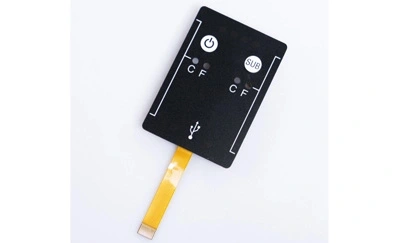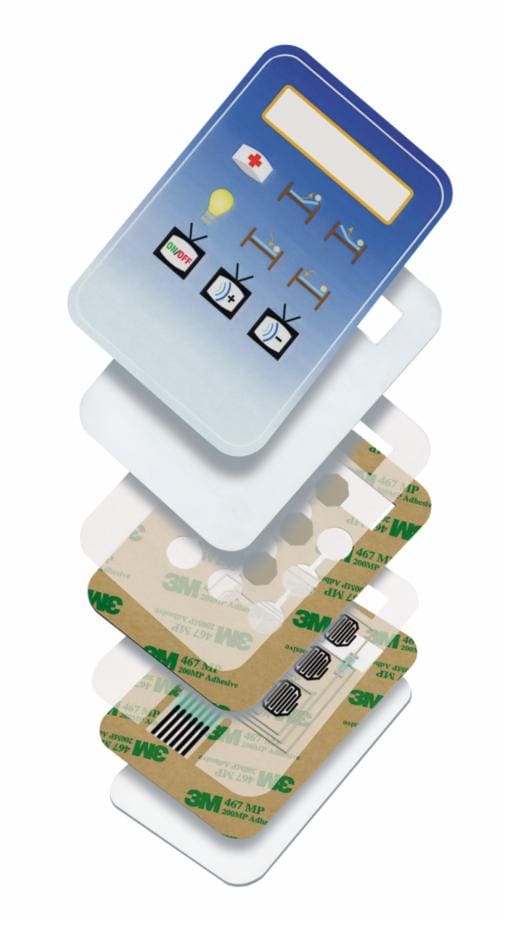The Production Process Behind Membrane Layer Switch: What You Required to Know
The manufacturing procedure behind membrane switches combines mindful style, product selection, and quality assurance. It begins with recognizing the complexities of membrane layer switch layout and progresses via various phases, consisting of material selections and printing techniques. Each phase plays an important duty in guaranteeing capability and resilience. The complexities of layer building and construction and the rigorous testing requirements might reveal insights that are not right away noticeable. What lies beyond these foundational aspects?
Recognizing Membrane Layer Switch Style
Although membrane layer buttons may appear basic initially look, their design involves complex factors to consider that assure functionality and sturdiness. The design process begins with a comprehensive understanding of individual demands, consisting of the user interface's designated application and environmental aspects. Comfort designs is a crucial element, as the format needs to assist in simplicity of use while guaranteeing that tactile feedback meets customer expectations.Moreover, the layering of parts, such as visuals overlays, sticky layers, and conductive traces, need to be exactly engineered. membrane switch. This layered arrangement not just influences the switch's responsiveness yet additionally affects its durability. Attention is offered to the securing methods employed to protect versus wetness and dust, which could endanger performance. Additionally, layout factors to consider include visual appeals, where color systems and visual clarity boost individual experience. Ultimately, the layout of membrane switches over equilibriums functionality, customer experience, and toughness, guaranteeing that they meet the needs of various applications properly
Materials Made Use Of in Membrane Switch Manufacturing
When selecting materials for membrane layer switch production, it is important to contemplate both efficiency and resilience. The key materials consist of polyester and polycarbonate films, which supply flexibility and stamina. These movies are typically covered with adhesive to assure proper bonding to substratums. Conductive inks, generally made up of silver or carbon, are crucial for developing electrical links within the button, allowing for trusted operation.Additionally, a protective layer, such as a difficult layer, is regularly applied to boost scratch resistance and durability. The selection of backing product, such as acrylic or foam, can significantly impact the switch's responsive feel and overall user experience. Moreover, numerous environmental variables, consisting of temperature level and humidity, need to direct product option to ensure peak performance in details applications. Eventually, the ideal mix of products contributes to the membrane button's capability and life expectancy, making educated selections important for makers.
The Printing Process: Creating Graphics and Text
The printing process in membrane switch manufacturing plays a substantial duty in generating high-quality graphics and text. Different graphic style methods are utilized to ensure aesthetic charm and performance, while cautious ink option techniques are necessary for longevity and efficiency. Understanding these components is basic for attaining finest lead to membrane button layout.
Graphic Layout Techniques
Graphic design methods play a necessary function in the printing process of membrane layer switches, as they define how graphics and message will eventually show up on the end product. Effective visuals style entails the critical use colors, designs, and fonts to enhance readability and visual appeal. Developers typically utilize vector graphics for scalability, making certain that photos stay sharp at different dimensions. In addition, attention to comparison and positioning is crucial, as it influences individual communication and visual quality. The incorporation of branding aspects, such as logo designs, must be managed with treatment to keep brand stability. Overall, thoughtful graphic design strategies contribute significantly to the performance and appearance of membrane layer switches, affecting customer experience and item performance.
Ink Choice Approaches
Selecting the suitable ink is essential for attaining the desired aesthetic quality and resilience in membrane switch manufacturing. Various ink types are utilized, including solvent-based, water-based, and UV-curable inks. Each type supplies distinct features, such as attachment, versatility, and resistance to environmental factors. Solvent-based inks are typically favored for their resilience and vibrant colors, while water-based inks are more environmentally friendly but may have limitations in adhesion. UV-curable inks provide rapid healing and durable efficiency. Furthermore, color matching methods guarantee that the selected inks straighten with layout requirements. Inevitably, the option of ink need to think about elements such as application method, substratum compatibility, and end-use needs to accomplish exceptional results in membrane layer button graphics and text.
Layer Building and Assembly

Material Choice Refine
A mindful option of products is essential in the manufacturing process of membrane switches, as it directly influences functionality and sturdiness. The main products made use of consist of polyester, polycarbonate, and numerous conductive inks. Polyester is typically preferred for its superb resistance to chemicals and abrasion, making it suitable for harsh environments. Polycarbonate, on the other hand, provides superior quality and influence resistance, which is advantageous for applications needing exposure and toughness. Conductive inks, usually composed of silver or carbon, are vital for creating reliable electric paths. Furthermore, the option of adhesive products influences the general stability of the switch - membrane switch. Evaluating variables such as ecological exposure, tactile comments, and aesthetic demands guides makers in choosing the most effective materials for their certain applications
Layer Adhesion Techniques
Sticking layers in membrane switch building and construction is an important procedure that guarantees capability and durability. Various attachment methods are employed to safeguard suitable bonding between layers, which typically consist of making use of adhesives, warmth, and stress. Pressure-sensitive adhesives (PSAs) are commonly made use of for their ease of application and prompt bonding abilities. In addition, thermal bonding methods can be applied, where warm is used to trigger adhesive properties, protecting a solid bond. The option of attachment technique greatly depends on the products involved and the certain application requirements of the membrane button. Proper positioning and consistent application of adhesives are important to protect against problems, safeguarding the switch operates successfully throughout its intended life expectancy.
Quality Assurance Measures
Ensuring top quality control during the layer building and setting up of membrane layer switches is important for keeping efficiency and reliability. This process normally entails several vital procedures, consisting of comprehensive assessments at each phase of manufacturing. Suppliers utilize advanced testing techniques, such as peel tests and bond analyses, to validate the honesty of layer bonds. In addition, aesthetic inspections are conducted to identify any problems in printing or material variances. Ecological conditions, such as temperature and humidity, are thoroughly kept an eye on to ensure suitable treating and bond. Additionally, routine calibration of devices helps maintain precise manufacturing criteria. By implementing these quality assurance actions, suppliers can considerably decrease the danger of product failure, assuring that the last membrane switches fulfill the called for specs and customer assumptions.
Examining and Quality Assurance Steps

Innovations in Membrane Layer Change Technology
As innovations in innovation remain to evolve, membrane layer switches are profiting from ingenious developments that boost their performance and customer experience. One significant development is the assimilation of capacitive touch innovation, which permits even more responsive and user-friendly interface. This change not only enhances aesthetic appeals but likewise reduces mechanical deterioration, extending the life expectancy of the switches.Additionally, advancements in graphic overlay products have caused improved longevity and resistance to environmental aspects such as moisture and UV light. These materials currently offer improved quality and brightness, additional boosting the visual appeal.Furthermore, the consolidation of clever technology is transforming membrane layer switches over into interactive control panels, making it possible for connection with IoT devices. This connectivity cultivates a smooth user experience, paving the method for applications in numerous industries, from healthcare to consumer electronic devices. Jointly, these innovations position membrane changes as essential components in modern gadget style.
Often Asked Inquiries
How much time Does the Membrane Switch Manufacturing Process Take?
The duration of the membrane layer switch manufacturing process can vary significantly. Variables such as intricacy, products useful reference made use of, and manufacturing quantity impact timelines, with regular manufacturing varying from a couple of days to numerous weeks for conclusion.
What Are the Usual Applications for Membrane Layer Buttons?
Membrane layer switches are frequently used in different markets, including automobile controls, home appliances, medical devices, and customer electronic devices (membrane switch). Their convenience and longevity make them ideal for applications requiring straightforward user interfaces and trustworthy efficiency Home Page in diverse environments
Can Membrane Layer Switches Over Be Personalized for Particular Needs?

What Is the Lifespan of a Normal Membrane Layer Switch Over?
The lifespan of a common membrane button differs, yet usually, it varies from 1 to 5 million cycles. Factors such as usage, environment, and material quality significantly affect longevity and total efficiency with time.

Are Membrane Changes Eco-friendly?
The environmental kindness of membrane layer changes varies. Some products used might not be recyclable, while others can be green. The total effect depends upon manufacturing products and practices, demanding mindful factor to consider throughout selection and disposal. The production procedure behind membrane changes combines cautious design, material option, and quality control. It begins with recognizing the ins and outs of membrane layer switch layout and advances through numerous phases, including product options and printing techniques. When picking materials for membrane layer switch production, it is crucial to consider both performance and longevity. A cautious selection of products is important in the production process of membrane layer switches, as it straight influences capability and sturdiness. The choice of bond method mainly depends on the materials included and the specific application demands of the membrane layer switch.